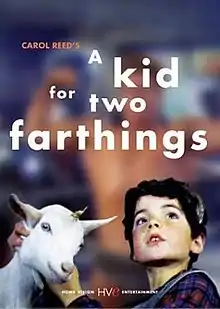A Kid for Two Farthings (film)
A Kid For Two Farthings is a 1955 film, directed by Carol Reed. The screenplay was adapted by Wolf Mankowitz from his own novel of the same name. The title is a reference to the traditional Passover song, Chad Gadya, which begins "One little goat which my father bought for two zuzim".[2] At the end of the film, Mr. Kandinsky softly sings fragments of an English translation of the song.
| A Kid For Two Farthings | |
|---|---|
 DVD Cover Art | |
| Directed by | Carol Reed |
| Produced by | Carol Reed |
| Written by | Wolf Mankowitz |
| Starring | Celia Johnson Diana Dors David Kossoff Joe Robinson |
| Music by | Benjamin Frankel |
| Cinematography | Edward Scaife |
| Edited by | Bert Bates |
Production company | |
| Distributed by | Romulus (UK) Lopert (US) |
Release date | 15 August 1955 1956 (USA) |
Running time | 96 minutes |
| Country | United Kingdom |
| Language | English |
| Budget | £200,000[1] |
It was one of the last films produced by Alexander Korda before his death.[3]
Plot
In the busy wholesale-retail world of London's East End everyone, it seems, has unattainable dreams. Then a small boy – Joe – buys a unicorn, in fact a sickly little goat, with just one twisted horn in the middle of its forehead. This, he has been led to believe by a local tailor, Kandinsky, will bring everyone good fortune.
The film has a haunting last image, of Kandinsky carrying the tiny body of the "unicorn" to the graveyard, whilst passing in the opposite direction is a Torah-reading Rabbi pushing a horn gramophone, a character that appears in the background several times during the film.
Cast
- Celia Johnson as Joanna
- Diana Dors as Sonia
- David Kossoff as Mr. Kandinsky
- Joe Robinson as Sam
- Jonathan Ashmore as Joe
- Brenda De Banzie as 'Lady' Ruby
- Primo Carnera as Python Macklin
- Lou Jacobi as Blackie Isaacs
- Irene Handl as Mrs. Abramowitz
- Danny Green as Bason
- Sydney Tafler as Madam Rita
- Sid James as Ice Berg
- Daphne Anderson as Dora
- Harry Baird as Jamaica
- Joseph Tomelty as Vagrant
- Harold Berens as Oliver
Production
Film rights to the novel were purchased by Carol Reed, who had made a popular film centering around a child a few years previously, The Fallen Idol. After making The Man Between Reed wanted to do something on a small scale in a studio.[4]
The role of the six year old went to Jonathan Ashmore.[5]
The New York Times called Diana Dors' casting "a surprise choice" because "she has made no films of consequence before and has usually been thought of as a kind of junior Marilyn Monroe."[6]
Filming started in June 1954. It took place at the studio and on location at Petticoat Lane in London. It was Carol Reed's first movie in colour.
Korda had just signed a deal with Romulus for them to distribute his movies. Kid for Two Farthings was the first.[7]
Reception
Critical response
Reviews for the film were mixed. Reed said, "I loved that book. The film was alright in parts but not in others. It cost very little money but did well."[8]
Filmink said it contained " an archetypal Dors performance in many ways – she’s down-to-earth, warm, kind, the best looking girl in a low-rent area (glamorous, but “East End” glamorous)."[9]
Awards
A Kid for Two Farthings was nominated for a Golden Palm at the 1955 Cannes Film Festival.[10]
Box Office
According to the Monthly Film Herald The film was the 9th most popular movie at the British box office in 1955, after The Dam Busters, White Christmas, Doctor at Sea, The Colditz Story, Seven Brides for Seven Brothers, Above Us the Waves, One Good Turn, and Raising a Riot. The film's popularity helped exhibitors vote Diana Dors the 9th most popular British star in British films (after Dirk Bogarde, John Mills, Norman Wisdom, Alastair Sim, Kenneth More, Jack Hawkins Richard Todd and Michael Redgrave, and in front of Alec Guinness.)[11]
Notes
- Wapshott, Nicholas (1990). The man between : a biography of Carol Reed. Chatto & Windus.
References
- Wapshott p 271
- Steven H. Gale, Mankowitz, Wolf, Literary Analysis, Encyclopedia of British Humorists, Vol. 2, 1996.
- DEATH OF SIR ALEXANDER KORDA The Irish Times 24 Jan 1956: 7.
- Wapshott p 269
- "THIS STAR IS NOT INTERESTED". The Beverley Times. Western Australia. 17 February 1955. p. 10 (Supplement). Retrieved 9 July 2020 – via National Library of Australia.
- NOTES ON THAMES FILMS: Olivier Transcribes 'Richard III' -Lean, Reed and Others in Action By STEPHEN WATTSLONDON. New York Times 29 Aug 1954: X5.
- "Korda to Distrib Pix". Variety. 21 July 1954. p. 1.
- Wapshott p 272
- Vagg, Stephen (7 September 2020). "A Tale of Two Blondes: Diana Dors and Belinda Lee". Filmink.
- "Festival de Cannes: A Kid for Two Farthings". festival-cannes.com. Retrieved 1 February 2009.
- "Dirk Bogarde favourite film actor". The Irish Times. 29 December 1955. p. 9.
External links
- A Kid for Two Farthings at IMDb
- A Kid for Two Farthings at the BFI's Screenonline
- A Kid for Two Farthings at the TCM Movie Database
- A Kid for Two Farthings at AllMovie
- Review of film at Variety
- Crowther, Bosley (18 April 1956). "Screen: Whimsical Tale; 'Kid for Two Farthings' Arrives at Plaza". The New York Times.